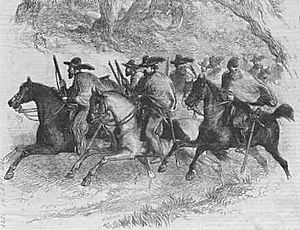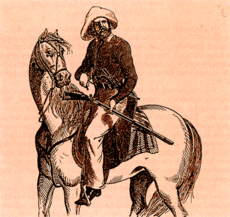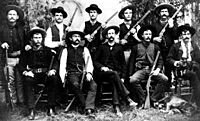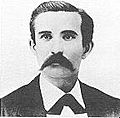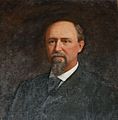History of the Texas Ranger Division facts for kids
The Texas Ranger Division started a long time ago, when the first American settlers came to what is now Texas. Back then, Texas was part of Mexico. The Rangers became famous for protecting the frontier, which was a wild area with few people. They had to deal with attacks from Native American tribes and, later, from Mexico.
A historian named T.R. Fehrenbach described the Rangers this way:
The Rangers were often called state troops or police. But for most of the 1800s, they were different. They weren't like a regular army or police force. Instead, they were a very skilled and tough group of fighters who helped keep law and order. They were needed because the frontier was like a war zone, and the people couldn't afford a regular army. Many Texans served as Rangers at different times. They were unique in the world.
Contents
How the Texas Rangers Started
In the early 1830s, many families from the United States settled in Texas. There was no regular army to protect them from Native American tribes and bandits. So, in 1823, Stephen F. Austin created small, unofficial armed groups. Their job was to "range" (travel) across the countryside for defense. This is how they got the name "rangers." Austin wrote that he would "... employ ten men ... to act as rangers for the common defense ..." Many historians believe the Texas Rangers officially began around this time.
However, the Texas Rangers were not officially formed until 1835. On October 17, a meeting of the Texas government decided to create the Rangers. They planned for three companies, totaling about 60 men. Their "uniform" was a light duster coat and a badge made from a Mexican peso. On November 24, lawmakers officially created the force. Robert McAlpin Williamson was chosen as the first Major of the Texas Rangers. Within two years, the group grew to over 300 men.
In their early days, Rangers protected the Texas frontier from Native American attacks on settlers. During the Texas Revolution, they worked as scouts, spies, and guides. They helped settlers escape the Mexican Army and supported the Texans. After Texas became the Republic of Texas, President Sam Houston wanted peace with Native Americans. This meant the Rangers had less to do.
Things changed when Mirabeau B. Lamar became president in 1838. Lamar believed in removing Native Americans from Texas. He saw the Rangers as the perfect group for this task. He got permission to raise a force of 56 Rangers. For the next three years, the Rangers fought against the Cherokee and Comanche tribes. They helped weaken the tribes' control over their lands.
Texas Rangers in the Mexican-American War
When Sam Houston was re-elected president in 1841, he saw that the Rangers were very effective. He increased their number to 150. Under Captain John Coffee "Jack" Hays', the Rangers played a key role in defending Texas from Mexican invasions and Native American attacks. Hays was a strong leader who brought the Rangers together. He also helped them get the new five-shot Colt Paterson revolver. The U.S. Army had turned down this gun, but Hays trained his men to shoot and reload it while on horseback. This was a new and powerful tactic.
Later, one of Hays's officers, Samuel Hamilton Walker, helped design an even better six-shot version, the Walker Colt. These revolvers were used by the U.S. Army in the Mexican-American War. During these years, famous Rangers like Hays, Walker, Benjamin McCulloch, and William "Bigfoot" Wallace became known as tough frontier fighters.
When Texas joined the United States in 1846, the Mexican–American War began. Several Ranger companies joined the federal army. They proved their bravery in battles like Palo Alto and Resaca de la Palma. The Rangers were excellent guerrilla fighters and guides because they knew the territory well. They helped the American army advance quickly. They also played important roles in the battles of Monterrey and Buena Vista.
When the U.S. Army entered Mexico City in 1847, the Rangers were with them. Mexicans called them los Diablos Tejanos (the "Texas Devils") because they were so feared. Their actions in the war made them famous across the United States. Stories about their bravery appeared in newspapers, making them part of American folklore.
After the Mexican-American War ended in 1848, most Rangers were disbanded. The U.S. Army was now in charge of protecting the frontiers. However, as more settlers moved into Native American lands, conflicts grew. In the 1850s, the Rangers were sometimes called back to deal with these problems. In 1857, Governor Hardin Richard Runnels brought them back as defenders of the Texas frontier.
In 1858, Governor Runnels gave $70,000 to fund the Rangers. John Salmon "Rip" Ford, a veteran Ranger, became the senior captain. Ford led about 100 Rangers on a large expedition against the Comanche and other tribes. These tribes had been raiding settlers' homes. On May 12, Ford's Rangers, along with Tonkawa, Anadarko, and Shawnee scouts, crossed into Indian Territory (now Oklahoma). They attacked a Comanche village, killing many and capturing prisoners and horses.
In 1859, Ford's company went to Brownsville in south Texas. A Mexican rancher named Juan Cortina had attacked the town and was leading raids against American landowners. Ford's Rangers, working with the U.S. Army, fought Cortina's forces. They defeated them in the battle of Rio Grande City. Cortina retreated into Mexico, and the threat of a large invasion ended.
These successful campaigns showed how important the Rangers were. The U.S. Army could not protect all of Texas's huge territory. The Rangers, with their knowledge of the land, were much more effective. This convinced Texans that a well-funded Ranger force was essential.
Civil War and Late 1800s
When Texas left the United States in 1861 during the American Civil War, many Rangers joined the Confederacy. Famous Rangers like Benjamin McCulloch and John Ford fought in the war. Even though the famous Eighth Texas Cavalry regiment was called Terry's Texas Rangers, most of its members were not part of the state Ranger agency. The fact that they used the Ranger name shows how famous the Rangers were. During the Civil War, older or disabled men took on Ranger-like duties, scouting for Union troops and hostile Native Americans.
During the Reconstruction period after the Civil War, the Rangers were replaced by the Texas State Police. This group was controlled by the Union and was not popular. It only existed from 1870 to 1873.
Things changed for the Rangers when Richard Coke became governor in 1874. He wanted to restore order in Texas. Native Americans and Mexican bandits were still a threat. So, the state government brought the Rangers back. They created a special group called the Frontier Battalion. It had six companies of 75 men each, led by Major John B. Jones. This group helped control criminals and defend against Native American tribes during a time of lawlessness.
Another group, the Special Force, was added. It had 40 men under Captain Leander H. McNelly. Their job was to bring order to south Texas, especially in the Nueces Strip area near Mexico. This region had many raids by bandits and Mexican leaders. Juan Cortina's men were still causing trouble. McNelly and his group worked hard to stop these threats.
Many of the Ranger myths began during this time. They became known for capturing or killing famous criminals like Sam Bass and John Wesley Hardin. They also played a key role in defeating the Comanche, Kiowa, and Apache peoples. However, the Rangers' actions during this period were sometimes very harsh. For example, McNelly and his men used brutal methods that were criticized. McNelly also sometimes disobeyed orders and crossed into Mexico to enforce the law. These actions helped restore order but also caused problems with Mexican-Americans. After McNelly retired due to health issues, the Special Force was dissolved in 1877. The Frontier Battalion continued its work. By the late 1800s, Texas's vast frontier was much safer, thanks largely to the Rangers.
Mexican Revolution and Early 1900s
By the early 1900s, Texas was more settled. The old laws for the Rangers were outdated. New laws were passed on July 8, 1901, and a new Ranger force was created. It had four companies, each with no more than 20 men. The Rangers now focused only on law enforcement.
The Mexican Revolution began in 1910, causing violence along the Texas-Mexico border. Mexican groups crossed the Rio Grande daily, attacking American communities for supplies and kidnappings. As law enforcement in Mexico broke down, these gangs joined different leaders in the civil war. Some simply used the chaos to loot. The situation worsened, with some groups aiming to drive Americans out of the Southwest. This was known as the Plan de San Diego in 1915. In a series of attacks, Mexicans and Villista guerrillas killed hundreds of Texans.
Texans were determined to regain control. Governor Oscar Branch Colquitt told Ranger Captain John R. Hughes, "... you and your men are to keep Mexican raiders off of Texas territory..." Hundreds of new special Rangers were appointed without careful checks. Many of these groups acted more like vigilante squads, taking the law into their own hands. There were increasing reports of Rangers abusing their power.
The Rangers used harsh methods to stop people from speaking out. In 1914, Rangers destroyed a printing press and arrested journalists at a newspaper in Laredo because it criticized the United States occupation of Veracruz. Rangers feared an uprising by non-white people in Texas due to the Plan of San Diego. They were involved in the killings of many Mexicans and Tejanos (Texans of Mexican descent) across the state.
The situation became even more serious on March 9, 1916, when Pancho Villa led 500 Mexican raiders in an attack on Columbus, New Mexico. They seized horses, burned the town, and killed soldiers and residents before retreating.
A very sad event was the Porvenir Massacre in January 1918. A group of Texas Rangers, ranchmen, and U.S. Cavalry troops went to the small village of Porvenir, Texas. They gathered all the men (fifteen Mexican men and boys, aged 16 to 72) and marched them away in the dark. A short distance from the village, these men were killed.
By the end of the decade, thousands of lives were lost. In January 1919, the Texas Legislature investigated the Rangers' actions. The investigation found that between 300 and 5,000 people, mostly of Hispanic background, had been killed by Rangers from 1910 to 1919. It also found that Rangers had been involved in many acts of brutality and unfairness.
These were very difficult times for the Rangers. To fix the problems and regain public trust, the Legislature passed a new law on March 31, 1919. All special Ranger groups were disbanded. The four official companies were kept, but their members were reduced from 20 to 15 each. They offered better pay to attract men with higher standards. A way for citizens to report complaints against Rangers was also created.
These changes helped. The new Ranger force slowly regained its good reputation. Under captains like Frank Hamer (who later became famous for leading the group that found Bonnie and Clyde), the Rangers were very active. They fought cattle rustlers, helped in labor disputes, and protected people during Ku Klux Klan events. When Prohibition began in 1920, their duties expanded to stopping liquor smugglers and illegal alcohol production.
One of the Rangers' biggest jobs during this time was bringing order to Texas's oil boomtowns. These towns had become very lawless. In the 1920s, martial law was declared in some towns like Mexia and Borger. In other towns like Desdemona and Kilgore, the situation was also bad. The Rangers were called in to calm things down and stop illegal activities. This continued into the 1950s, but the Rangers prevented it from becoming an even bigger problem.
Modern Rangers
The Great Depression in the 1930s forced governments to cut spending. The Rangers were affected too. The number of officers was cut to 45. They could only travel by free railroad passes or their own horses. The situation got worse when the Rangers got involved in politics in 1932. They publicly supported Governor Ross S. Sterling for re-election. But his opponent, Miriam Amanda "Ma" Ferguson, won. When she took office in 1933, she fired all the Rangers. Their salaries and funds were also cut, and their numbers dropped to 32 men.
This made Texas a safe place for many famous gangsters of the Depression era, like Bonnie and Clyde, George "Machine Gun" Kelly, and Pretty Boy Floyd. Many unqualified people were quickly appointed as Rangers, but they couldn't stop the rising crime.
The state government realized that law enforcement was very disorganized. They hired a consulting firm to study the problem. The report found that crime levels in Texas were very high, and the state's police forces were underfunded, understaffed, and disorganized. The consultants suggested merging the Rangers with the Texas Highway Patrol into a new agency called the Texas Department of Public Safety (DPS). The Legislature agreed, and the DPS started on August 10, 1935, with a budget of $450,000.
The 1935 reforms largely shaped the Texas Rangers' organization as it is today. Hiring new members became based on exams and merit, not politics. Promotions were based on experience and performance. They also got better tools for fighting crime, like cars, advanced weapons, and forensics labs. By the late 1930s, the Rangers had one of the best crime labs in the United States. Under Colonel Homer Garrison, who became director of the DPS in 1938, the Rangers worked to restore their good name. They kept their traditions while adapting to a modern society. The number of officers grew, and the Rangers focused on detective work, while the Highway Patrol handled direct law enforcement.
The Rangers have continued to improve their training, funding, and technology. In recent decades, they have solved thousands of cases, including many important ones. The agency now includes officers from different ethnic backgrounds, including Hispanic and African American members. Today, the Texas Rangers are so important to Texas history that a law protects them from ever being disbanded.
Notable Texas Rangers


